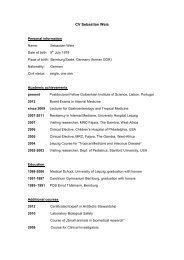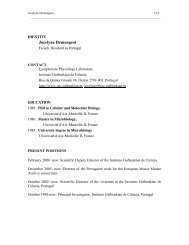organisation - the Instituto Gulbenkian de Ciência
organisation - the Instituto Gulbenkian de Ciência
organisation - the Instituto Gulbenkian de Ciência
- No tags were found...
Create successful ePaper yourself
Turn your PDF publications into a flip-book with our unique Google optimized e-Paper software.
THE HIPPO TUMOR SUPPRESSOR PATHWAY AND THE SRC PROTO-ONCOGENE<br />
REGULATE DISTINCT F-ACTIN NETWORKS.<br />
Eukaryotic cells generate a diversity of F-actin networks. We observed that<br />
Hippo and Src signaling activities control distinct F-actin webs at specific subcellular<br />
locations. Moreover, we i<strong>de</strong>ntified ABPs specifically involved in mediating<br />
Hpo or Src signaling activities. This argues that <strong>the</strong> geometrical, mechanical<br />
and dynamic properties of each F-actin network are specifically adapted to<br />
regulate Hippo and Src signaling activities (Gaspar et al., in preparation).<br />
THE EYE SELECTOR GENE DACHSHUND PROMOTES CYTOSKELETAL<br />
REARRANGEMENT AND EXIT FROM THE FURROW STATE.<br />
Despite <strong>the</strong> fact that epi<strong>the</strong>lium architecture constrains cells in <strong>the</strong>ir ability to<br />
move, <strong>the</strong>y can be engaged in a large number of morphogenetic rearrangements<br />
and adopt a different repertoire of cell shape. Actin filaments (F-actin) are major<br />
<strong>de</strong>terminant of cell shape and can form a diversity of networks with precise<br />
mechanical and dynamic properties. Although it becomes increasingly clear that<br />
cell shape has a critical impact on cell differentiation and tissue morphogenesis,<br />
<strong>the</strong> role of cell architecture in <strong>the</strong>se processes is far from clear.<br />
We aimed in this project to get insight on how F-actin is regulated to promote<br />
cell shape changes and how this impacts on tissue morphogenesis and cell differentiation.<br />
To do so, we used <strong>the</strong> <strong>de</strong>veloping Drosophila eye, to investigate<br />
<strong>the</strong> role of actin isoforms, actin regulatory proteins, eye selector genes and<br />
signaling pathways in triggering cell shape changes required for neuronal differentiation.<br />
Dachshund (dac), <strong>the</strong> most downstream element among <strong>the</strong> known RDGN,<br />
enco<strong>de</strong>s a nuclear protein related to <strong>the</strong> Sno/Ski protein family of proto-oncogenes.<br />
We found that Dac promotes cell shape required for proper differentiation<br />
of <strong>the</strong> retina. Our results argue that one function of <strong>the</strong> Dac nuclear<br />
factor is to regulate cytoskeletal rearrangement required to exit <strong>the</strong> furrow<br />
state <strong>the</strong>reby controlling <strong>the</strong> timing of differentiation (Brás-Pereira et al., in<br />
preparation).<br />
THE RETINAL DETERMINATION GENE DACHSHUND ENSURES PATTERNED CELL<br />
PROLIFERATION BY LIMITING YORKIE FUNCTION<br />
Recent studies have <strong>de</strong>monstrated an important role for <strong>the</strong> human Dac homolog<br />
DACH1 in tumorigenesis. We showed that in <strong>the</strong> Drosophila eye imaginal<br />
disc, Dac suppresses inappropriate tissue growth by inhibiting Yorkie activity,<br />
which mediates Hippo signaling. Since Dac interacts physically with <strong>the</strong> Yorkiebinding<br />
partner Homothorax, our findings indicate that Dac is recruited to <strong>the</strong><br />
promoter of Yorkie targets to inactivate proliferation and survival genes (Brás-<br />
Pereira et al., in preparation).<br />
HOMEOSTASIS OF THE DROSOPHILA ADULT RETINA BY CAPPING PROTEIN<br />
AND THE HIPPO PATHWAY<br />
The conserved Hippo signaling pathway regulates multiple cellular events, including<br />
tissue growth, cell fate <strong>de</strong>cision and neuronal homeostasis. We provi<strong>de</strong><br />
evi<strong>de</strong>nce that <strong>the</strong> actin cytoskeleton promotes neuronal homeostasis of <strong>the</strong><br />
adult Drosophila retina through misregulation of <strong>the</strong> Hippo pathway. We propose<br />
a mo<strong>de</strong>l by which F-actin dynamics is involved in all processes that require<br />
<strong>the</strong> activity of <strong>the</strong> core Hippo kinase module (Brás-Pereira et al., 2011).<br />
IGC ANNUAL REPORT ‘11<br />
RESEARCH GROUPS<br />
44






